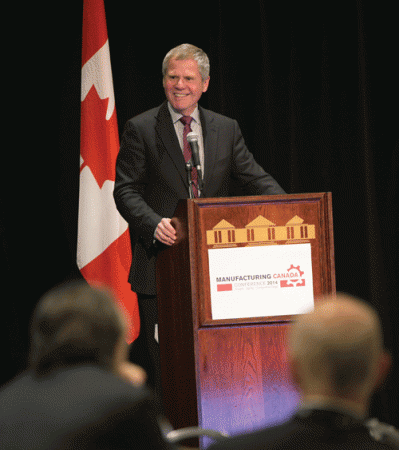
Q&A with Jayson Myers
By PLANT STAFF
Business Operations Economy Industry Operations Manufacturing Canadian Manufacturers & Exporters CME Exports growth Imports Innovation Jayson Myers tim hudakWith change comes opportunity, says Canadian Manufacturers' & Exporters CEO.
PLANT’s assistant editor Matt Powell caught up with CME’s chief executive and economist at the Manufacturing Canada 2014 Conference, where he discussed challenges posed by change and the opportunities that lie ahead.
You mentioned in a speech at a Kitchener Waterloo Chamber of Commerce event that you think manufacturing is going through a transformation. What do you mean by that?
There are four big drivers of change.
The first is access to new markets. The recession taught a lot of manufacturers that they have to find new customers, which will require better products, production systems, technology and processes.
Those new customers are coming from international markets such as Europe and Asia, but also from the US where the economy has rebounded. In Canada, there’s a trillion dollars of business opportunity in energy, infrastructure and resource projects.
Secondly, new technologies such as additive manufacturing, mechatronics, the connection between IT and machining, products and systems, and new materials in biotechnology and nanotechnology are important. There’s also big data and how that information is used, which is changing processes as well as the business side.
Third is changing customer and stakeholder expectations for processes such as sustainable development and manufacturing, and the social licence to operate. Then there are customers looking for an experience with products – a huge change and opportunity.
Fourth is the competition, and that’s always driving change, now so more than ever.
Canadian companies need to see these challenges as opportunities that are reshaping the industry. Five years from now, businesses can’t operate the way they do today.
RELATED:
Manufacturing Canada 2014: Show coverage [PHOTO GALLERY]
A few years ago CME articulated a vision of what manufacturing should look like by 2020. Is the transformation on track?
In many ways, I think change is happening a lot sooner. There are new technologies that weren’t even on the radar when we put that plan together, such as the challenge of getting into the US market.
We must look at the business of manufacturing and focus on customer solutions rather than just getting product out the door. Implementing the policies necessary to sustain new processes is key.
Most Canadian manufacturers appear to be reluctant to look beyond North America. How will companies act on new
opportunities presented by recent trade deals?
We’ve established a network called the Enterprise Europe network to identify qualified leads for companies looking for technology partnerships in Europe. We’ve already done 26 joint ventures.
I see a lot of small and mid-sized European companies looking for partnerships here to gain access to the North American market.
Canada’s a pretty attractive market of sophisticated technology and with the sources that we have, there are big opportunities for direct partnerships, export activity and investment because there are lots of companies that look to Europe for growth.
But we also need to understand that direct exporting is not the only opportunity through the trade deal. They make Canada a very attractive place for multinationals to invest because they’ll have access to both Europe and the US. I see a lot of Canadian suppliers getting access to multinationals and becoming part of their supply chains.
Tim Hudak is against what he calls “corporate welfare” but Kathleen Wynne describes it as partnering with industry. Your thoughts?
[Ontario Progressive Conservative leader] Tim Hudak needs to reassess his view on the role of government. It needs to be a partner with business, and maybe that’s providing low cost energy or working with educational and training institutions or simply getting the red tape out of the way. But when you’re up against other governments in the US that are actively subsidizing and providing lucrative incentives for companies to go south, you need to be in the game.
Hudak’s right about the need for governments to set the right business conditions, but if they want economic growth from manufacturing, they have to be prepared to put some money on the table. It’s not about subsidizing failures. They must provide seed money to encourage investment, particularly in Canada where it’s still impossible to get venture capital.
This interview has been edited.
The Manufacturing Canada 2014 Conference, presented in May by CanadianManufacturing.com and PLANT magazine, brought together more than 200 business leaders for a one-day forum focused on the technologies, strategies and innovation driving competitiveness.
This article appears in the May/June 2014 issue of PLANT.

